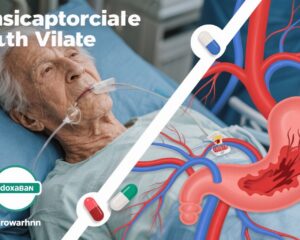Highlight
1. Edoxaban showed comparable efficacy to warfarin in preventing stroke or systemic embolism early after surgical bioprosthetic valve replacement.
2. Safety analysis revealed no fatal bleeding or intracranial hemorrhage in patients on edoxaban, contrasting with one fatal intracranial hemorrhage in the warfarin group.
3. The incidence of intracardiac thrombus was zero in the edoxaban group but occurred at 1% in the warfarin group.
4. These findings suggest edoxaban as a feasible anticoagulant alternative within three months post-bioprosthetic valve surgery.
Study Background and Disease Burden
Bioprosthetic valve replacement is a common surgical procedure to restore valvular function in patients with valvular heart disease. Postoperatively, patients face an elevated risk of thromboembolism, particularly stroke or systemic embolism, due to the prothrombotic state induced by surgery and prosthetic material. Current clinical guidelines generally recommend anticoagulant therapy with vitamin K antagonists (VKAs) such as warfarin for 3 to 6 months after bioprosthetic valve implantation to mitigate this risk.
However, VKAs require frequent monitoring and dose adjustment and carry notable bleeding risks, including intracranial hemorrhage. Direct oral anticoagulants (DOACs), including edoxaban, have revolutionized anticoagulation due to predictable pharmacokinetics, fewer food and drug interactions, and no need for routine blood monitoring. Despite these advantages, evidence supporting the safety and efficacy of DOACs in early anticoagulation after surgical bioprosthetic valve replacement remains limited, creating a crucial knowledge gap.
Study Design
The ENBALV trial, an investigator-initiated, phase 3, randomized, open-label, multicenter study in Japan, was designed to evaluate the efficacy and safety of edoxaban compared to warfarin within three months following surgical bioprosthetic valve replacement in the aortic and/or mitral position.
Between the two groups, 410 patients were initially enrolled and randomized (edoxaban group: n=195; warfarin group: n=194), with 389 patients included in the final analysis. The mean age was 73±6 years, with 56.8% male and 79.4% presenting in sinus rhythm at baseline.
The primary outcome was a composite of stroke or systemic embolism during the 3-month follow-up period. Secondary outcomes included major bleeding events, intracardiac thrombus formation, and a composite endpoint of stroke, systemic embolism, or major bleeding. Given the relatively short study duration and low event rate, the trial primarily assessed differences in event rate point estimates between the two groups.
Key Findings
Efficacy Outcomes: The primary outcome of stroke or systemic embolism occurred in 0.5% (n=1) of patients in the edoxaban group compared to 1.5% (n=3) in the warfarin group. The risk difference was -1.03% with a 95% confidence interval (CI) ranging from -4.34 to 1.95%, indicating no statistically significant difference but suggesting a numerically lower event rate with edoxaban.
Safety Outcomes: Major bleeding was observed in 4.1% (n=8) of patients receiving edoxaban, compared to 1.0% (n=2) in the warfarin arm. Although the increased bleeding risk with edoxaban yielded a risk difference of 3.07% (95% CI: -0.67 to 7.27%), this was not statistically definitive given the CI crossing zero.
Importantly, fatal bleeding or intracranial hemorrhage (ICH) was absent in the edoxaban group, whereas one fatal intracranial hemorrhage occurred in the warfarin group. These data may infer a safer profile concerning catastrophic bleeding with edoxaban.
Thrombosis Outcomes: No intracardiac thrombus formation was detected in the edoxaban group, whereas 1.0% (n=2) of patients in the warfarin group developed intracardiac thrombi.
| Outcome | Edoxaban (n=195) | Warfarin (n=194) | Risk Difference (95% CI) |
|---|---|---|---|
| Stroke or Systemic Embolism | 0.5% (1) | 1.5% (3) | -1.03% (-4.34 to 1.95%) |
| Major Bleeding | 4.1% (8) | 1.0% (2) | 3.07% (-0.67 to 7.27%) |
| Fatal Bleeding / Intracranial Hemorrhage | 0 | 1 fatal ICH | Not calculable |
| Intracardiac Thrombus | 0 | 1.0% (2) | Not calculable |
Expert Commentary
The ENBALV trial provides clinically relevant prospective evidence supporting edoxaban as a viable anticoagulant option during the early postoperative period following bioprosthetic valve replacement. Given the burden of routine monitoring and variable therapeutic windows with warfarin, the results hold promise for simplified management with DOACs.
Clinicians should note the observed trend towards higher major bleeding with edoxaban, though the absence of fatal or intracranial hemorrhages could confer a safety advantage. The study’s open-label design and limited follow-up period warrant cautious interpretation. Larger, longer-term randomized trials are needed to definitively establish comparative benefits and inform guideline updates.
The total patient population was elderly with a predominance of sinus rhythm, which aligns well with real-world surgical cohorts, enhancing generalizability. The mechanistic rationale hinges on edoxaban’s selective factor Xa inhibition, producing effective anticoagulation with potentially fewer bleeding complications than VKAs.
Conclusion
The ENBALV randomized trial suggests that edoxaban offers an effective and generally safe alternative to warfarin for anticoagulation in the first three months after surgical bioprosthetic valve replacement. While efficacy in stroke prevention is comparable, the safety profile—with zero fatal bleeding or intracranial hemorrhages observed—points to its potential clinical utility.
Future research with larger sample sizes and longer durations is necessary to confirm these findings and integrate DOACs more confidently into postoperative anticoagulation strategies for this patient population.
References
Izumi C, Amano M, Yoshikawa Y, Fukushima S, Yaku H, Eishi K, Sakaguchi T, Ohno N, Hiraoka A, Okada K, Saiki Y, Miura T, Komiya T, Minami M, Yamamoto H, Omae K; ENBALV Trial Investigators. Efficacy and Safety of Edoxaban in Anticoagulant Therapy Early After Surgical Bioprosthetic Valve Replacement: A Randomized Clinical Trial. Circ Cardiovasc Interv. 2025 Jul;18(7):e015108. doi: 10.1161/CIRCINTERVENTIONS.124.015108. Epub 2025 May 12. PMID: 40663622. URL: https://jrct.niph.go.jp/latest-detail/jRCT2051210209



